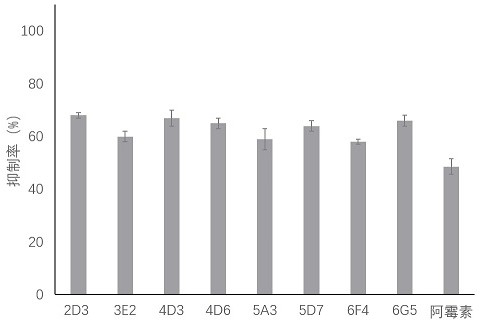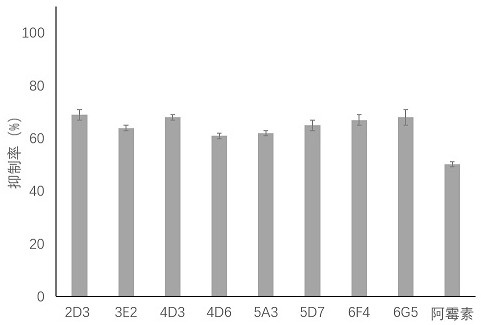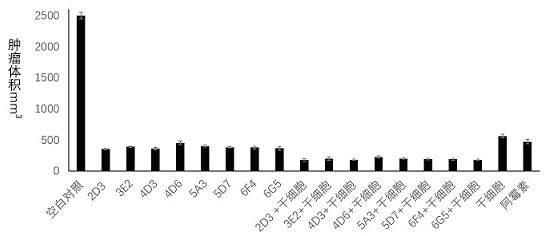Application of bone marrow mesenchymal stem cells combined with monoclonal antibodies in cancer treatment
A technology of monoclonal antibody and bone marrow mesenchyme, which is applied in the direction of antibody medical components, antibodies, anti-receptor/cell surface antigen/cell surface determinant immunoglobulin, etc., which can solve the problem of combining stem cells and therapeutic antibodies. , proliferative ability, tumor cell metastasis potential decline, etc., to achieve the effect of inhibiting proliferation and good application prospects
- Summary
- Abstract
- Description
- Claims
- Application Information
AI Technical Summary
Problems solved by technology
Method used
Image
Examples
Embodiment 1
[0045] Example 1 Preparation of Liver Cancer-specific Monoclonal Antibody
[0046] (1) Hepatoma Huh-7 cells and HepG2 cells cryopreserved in liquid nitrogen were thawed in a water bath at 30°C, transferred to centrifuge tubes and added with 10 ml of serum-free RPMI 1640 medium, centrifuged at 1000 r / min for 6 min, and the supernatant was discarded. The cell pellets were pipetted with RPMI1640 complete medium and then transferred to cell culture flasks respectively, and the medium was filled up to about 8 ml respectively, cultured in a 37°C, 5% CO2 incubator for 2 days, and the cells were collected for use.
[0047] The preparation method of liver cancer cell specific monoclonal antibody is as follows:
[0048] Animal immunization: select 10-week-old female Balb / c mice.
[0049] (1) Initial immunization: 150 μg of antigen (liver cancer Huh-7 cells: HepG2 cells = 1:1) and complete Freund's adjuvant at a volume ratio of 1:1 were emulsified and injected subcutaneously at multiple...
Embodiment 2
[0075] Example 2 Western blot identification of the specificity of the purified monoclonal antibody
[0076] Two kinds of liver cancer cells were lysed to extract proteins, and the lysed proteins of human epidermal cells and HeLa cells were used as controls. After reduced SDS-PAGE electrophoresis, the protein bands were transferred to PVDF membranes by 120mA constant current electrophoresis for 30 minutes. , blocked with 5% skimmed milk powder (TBST configuration, ready-to-use) at room temperature for 2 hours, discarded the blocking solution, and washed 3 times with TBST; the purified 8 kinds of monoclonal antibodies were diluted 1:250 with 5% skimmed milk powder, Incubate overnight at 4°C, wash 3 times with TBST; add HRP-labeled goat anti-mouse IgG (H+L) secondary antibody (1:5000 dilution), incubate on a shaker at room temperature for 1 hour, wash 3 times with TBST; appropriate amount of chemiluminescent solution After incubation for 5 min, the images were scanned using an A...
Embodiment 3
[0077] Example 3 Affinity determination of monoclonal antibody by SPR
[0078] Antibodies were characterized for their binding kinetics by SPR assay using a BIAcore™ T-200. Changes in surface plasmon resonance signals were analyzed to calculate association rates (kon) and dissociation rates (koff) by using a one-to-one Langmuir binding model. Equilibrium dissociation constants (KD) were calculated as the ratio koff / kon. The specific binding affinity profiles of monoclonal antibodies to liver cancer Huh-7 cells are shown in Table 2.
[0079] Table 2. Comparison of antibody binding affinities by SPR
[0080] Antibody name KD (nM) 2D3 0.23 3E2 0.56 4D3 0.29 4D6 0.31 5A3 0.58 5D7 0.45 6F4 0.62 6G5 0.34
[0081] It can be seen from Table 2 that the eight monoclonal antibodies all have good affinity.
PUM
 Login to View More
Login to View More Abstract
Description
Claims
Application Information
 Login to View More
Login to View More - R&D
- Intellectual Property
- Life Sciences
- Materials
- Tech Scout
- Unparalleled Data Quality
- Higher Quality Content
- 60% Fewer Hallucinations
Browse by: Latest US Patents, China's latest patents, Technical Efficacy Thesaurus, Application Domain, Technology Topic, Popular Technical Reports.
© 2025 PatSnap. All rights reserved.Legal|Privacy policy|Modern Slavery Act Transparency Statement|Sitemap|About US| Contact US: help@patsnap.com



